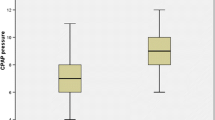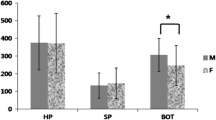Abstract
Purpose
To evaluate, using drug-induced sleep endoscopy (DISE), sites of upper airway obstruction and pattern of collapse in patients over 65 years old affected by obstructive sleep apnea. To compare sites and pattern of collapse of elderly patients with a group of patients younger than 65 years.
Methods
A group of 55 patients aged over 65 years were enrolled in this prospective study. Fifty patients under 65 years old were collected in the control group. Polysomnographic data and clinical parameters such as the daytime sleepiness, and body mass index were evaluated for both groups of patients. All patients underwent DISE examination with VOTE classification.
Results
The AHI value increased with aging whereas elderly patients presented a reduction in daytime sleepiness. Elderly patients showed a higher incidence of total collapse in the velum region compared to younger patients (90.9% vs 70%;); the older patients showed a lower degree of total oropharyngeal lateral wall collapse with respect to younger patients, (20% vs 50%). No difference in tongue base collapse emerged between the two subgroups of patients.
Conclusion
Elderly patients showed a higher incidence of total collapse in the velum and a lower incidence in the oropharyngeal lateral wall compared to younger patients.


Similar content being viewed by others
References
Bosi M, De Vito A, Gobbi R, Poletti V, Vicini C (2017) The importance of obstructive sleep apnoea and hypopnea pathophysiology for customized therapy. Eur Arch Otorhinolaryngol 274:1251–1261
Magliulo G, de Vincentiis M, Iannella G et al (2018) Eustachian tube evaluation in patients with obstructive sleep apnea syndrome. Acta Otolaryngol 138:159–164
Shochat T, Pillar G (2003) Sleep apnoea in the older adult: pathophysiology, epidemiology, consequences and management. Drugs Aging 20:551–560
Young T, Shahar E, Nieto FJ et al (2002) Predictors of sleep-disordered breathing in community-dwelling adults: the sleep heart health study. Arch Intern Med 162:893–900
Magliulo G, De Vincentiis M, Iannella G et al (2018) Olfactory evaluation in obstructive sleep apnoea patients. Acta Otorhinolaryngol Ital 38:338–345
Yaremchuk K (2018) Sleep disorders in the elderly. Clin Geriatr Med 34:205–216
Ancoli-Israel S, Kripke DF, Klauber MR, Mason WJ, Fell R, Kaplan O (1991) Sleep-disordered breathing in community-dwelling elderly. Sleep 14:486–495
Ancoli-Israel S, Kripke DF, Klauber MR et al (1996) Morbidity, mortality and sleep-disordered breathing in community dwelling elderly. Sleep 19:277–282
Morrell MJ, Finn L, McMillan A, Peppard PE (2012) The impact of ageing and sex on the association between sleepiness and sleep disordered breathing. Eur Respir J 40:386–393
McMillan A, Morrell MJ (2016) Sleep disordered breathing at the extremes of age: the elderly. Breathe (Sheff) 12:50–60
Suzuki K, Miyamoto M, Hirata K (2017) Sleep disorders in the elderly: diagnosis and management. J Gen Fam Med 18:61–71
Ahmad N, Srinivasan K, Naicker TR, Moudgil H (2014) Sleep apnoea in the elderly. Lancet Respir Med 2:21
Peppard PE, Young T, Barnet JH, Palta M, Hagen EW, Hla KM (2013) Increased prevalence of sleep-disordered breathing in adults. Am J Epidemiol 177:1006–1014
Carlisle T, Carthy ER, Glasser M et al (2014) Upper airway factors that protect against obstructive sleep apnoea in healthy older males. Eur Respir J 44:685–693
Schwab RJ, Gupta KB, Gefter WB, Metzger LJ, Hoffman EA, Pack AI (1995) Upper airway and soft tissue anatomy in normal subjects and patients with sleep-disordered breathing. Significance of the lateral pharyngeal walls. Am J Respir Crit Care Med 152:1673–1689
Malhotra A, Huang Y, Fogel R et al (2006) Aging influences on pharyngeal anatomy and physiology: the predisposition to pharyngeal collapse. Am J Med 119:9–14
Jang MS, Kim HY, Dhong HJ et al (2014) Effect of parapharyngeal fat on dynamic obstruction of the upper airway in patients with obstructive sleep apnea. Am J Respir Crit Care Med 190:1318–1321
Bosi M, De Vito A, Vicini C, Poletti V (2017) The role of compact polysomnography/polygraphy in sleep breathing disorder patients’ management. Eur Arch Otorhinolaryngol 274:2013–2028
De Vito A, Carrasco Llatas M, Ravensloot M et al. (2018) European position paper on drug-induced sleep endoscopy (DISE): 2017 update. Clin Otolaryngol. https://doi.org/10.1111/coa.13213
Charakorn N, Kezirian EJ (2016) Drug-induced sleep endoscopy. Otolaryngol Clin North Am 49:1359–1372
Campanini A, Canzi P, De Vito A, Dallan I, Montevecchi F, Vicini C (2010) Awake versus sleep endoscopy: personal experience in 250 OSAHS patients. Acta Otorhinolaryngol Ital 30:73–77
De Vito A, Agnoletti V, Zani G et al (2017) The importance of drug-induced sedation endoscopy (D.I.S.E.) techniques in surgical decision making: conventional versus target controlled infusion techniques-a prospective randomized controlled study and a retrospective surgical outcomes analysis. Eur Arch Otorhinolaryngol 274:2307–2317
Koo SK, Choi JW, Myung NS, Lee HJ, Kim YJ, Kim YJ (2013) Analysis of obstruction site in obstructive sleep apnea syndrome patients by drug induced sleep endoscopy. Am J Otolaryngol 34:626–630
Ravesloot MJ, de Vries N (2011) One hundred consecutive patients undergoing drug-induced sleep endoscopy: results and evaluation. Laryngoscope 121:2710–2716
Golbin D, Musgrave B, Succar E, Yaremchuk K (2016) Clinical analysis of drug-induced sleep endoscopy for the OSA patient. Laryngoscope 126:249–253
Richard B, Berry R, Brooks CE, Gamaldo et al (2015) AASM manual for the scoring of sleep and associated events. American Academy of Sleep Medicine, Darien
Epstein LJ, Kristo D, Strollo PJ Jr et al (2009) Clinical guideline for the evaluation, management and long-term care of obstructive sleep apnea in adults. J Clin Sleep Med 5:263–276
De Vito A, Carrasco Llatas M, Vanni A et al (2014) European position paper on drug-induced sedation endoscopy (DISE). Sleep Breath 18:453–465
De Vito A, Agnoletti V, Berrettini S et al (2011) Drug-induced sleep endoscopy: conventional versus target controlled infusion techniques—a randomized controlled study. Eur Arch Otorhinolaryngol 268:457–462
Lo YL, Ni YL, Wang TY et al (2015) Bispectral index in evaluating effects of sedation depth on drug-induced sleep endoscopy. J Clin Sleep Med 11:1011–1020
Traxdorf M, Tschaikowsky K, Scherl C, Bauer J, Iro H, Angerer F (2016) Drug-induced sleep endoscopy (DISE) with target controlled infusion (TCI) and bispectral analysis in obstructive sleep apnea. J Vis Exp 6:18
Kezirian EJ, Hohenhorst W, de Vries N (2011) Drug-induced sleep endoscopy: the VOTE classification. Eur Arch Otorhinolaryngol 268:1233–1236
Levendowski DJ, Oksenberg A, Vicini C, Penzel T, Levi M, Westbrook PR (2018) A systematic comparison of factors that could impact treatment recommendations for patients with positional obstructive sleep apnea (POSA). Sleep Med 50:145–151
Safiruddin F, Koutsourelakis I, de Vries N (2014) Analysis of the influence of head rotation during drug-induced sleep endoscopy in obstructive sleep apnea. Laryngoscope 124:2195–2199
George E, Katerina V, Maria S, Lambros B, Konstantina N, Dimitrios G (2012) Clinical features and polysomnographic findings in greek male patients with obstructive sleep apnea syndrome: differences regarding the age. Sleep Disord 2012:324
Heinzer RC, Stanchina ML, Malhotra A et al (2006) Effect of increased lung volume on sleep disordered breathing in patients with sleep apnoea. Thorax 61:435–439
Torre C, Camacho M, Liu SY, Huon LK, Capasso R (2016) Epiglottis collapse in adult obstructive sleep apnea: a systematic review. Laryngoscope 126:515–523
Gouveia CJ, Cramer JD, Liu SY, Capasso R (2017) Sleep surgery in the elderly: lessons from the national surgical quality improvement program. Otolaryngol Head Neck Surg 156:757–764
Wilhelm CP, deShazo RD, Tamanna S, Ullah MI, Skipworth LB (2015) The nose, upper airway, and obstructive sleep apnea. Ann Allergy Asthma Immunol 115:96–102
Funding
None.
Author information
Authors and Affiliations
Corresponding author
Ethics declarations
Conflict of interest
The authors declare that they have no conflict of interest.
Ethical approval
All procedures performed in studies were in accordance with the ethical standards of the institutional committee of the Morgagni Pierantoni Hospital and with the 1964 Helsinki declaration.
Informed consent
Informed consent was obtained from all individual participants included in the study.
Rights and permissions
About this article
Cite this article
Vicini, C., De Vito, A., Iannella, G. et al. The aging effect on upper airways collapse of patients with obstructive sleep apnea syndrome. Eur Arch Otorhinolaryngol 275, 2983–2990 (2018). https://doi.org/10.1007/s00405-018-5163-5
Received:
Accepted:
Published:
Issue Date:
DOI: https://doi.org/10.1007/s00405-018-5163-5




